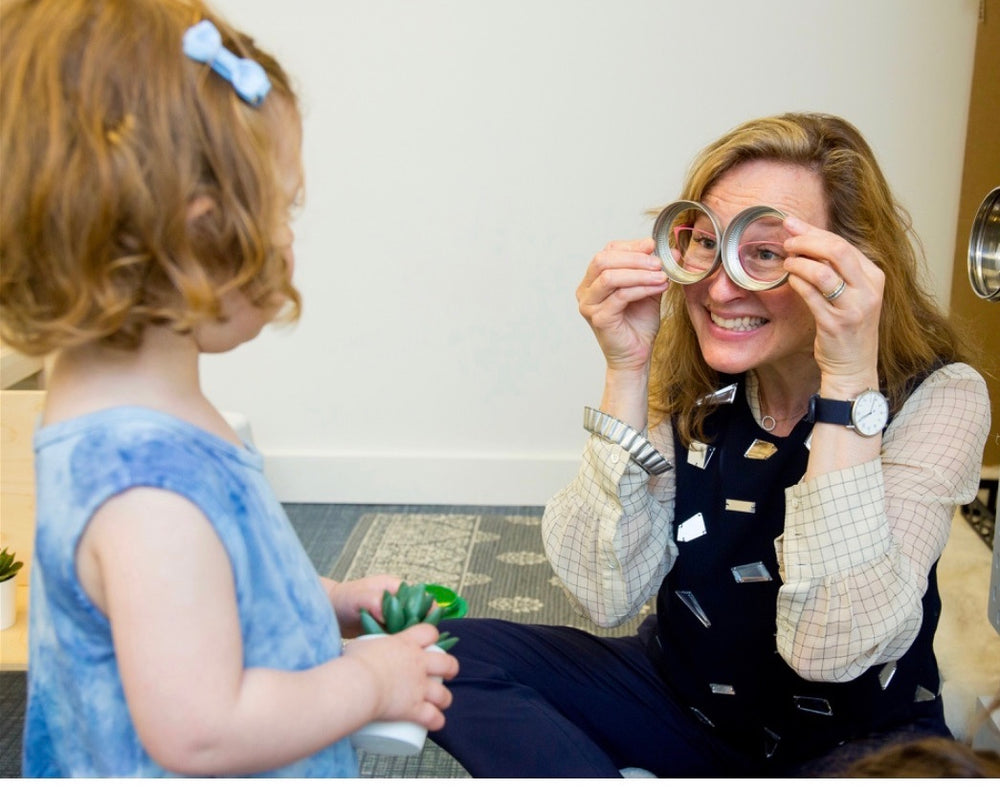The Everyday Play Deck: 5 Questions with Lisa Zaretsky of playAGAIN


When I first met Lisa, she arrived to our meeting carrying a big bag that was filled with an assortment of household materials. Within minutes she had pulled out a bowl and a fly swatter and was demonstrating the multitude of ways that these items could be used to spark play. I was transfixed by her ability to see such possibility in everyday items. We began chatting about our shared education at Bank Street College, Lisa's beloved early childhood program playAGAIN and the role of repurposed materials in play. As I listened to Lisa speak, it was clear to me that she understood and celebrated child development in a strikingly unique way that filled me with joy and inspiration.
Fast forward many months and meetings later and I am thrilled to share that together, playAGAIN and Rose & Rex, are launching a new product, the Everyday Play Deck, this summer. The deck is designed to answer the question, "What can you do with what you already have?" and offers Lisa's invitations to play the repurposed way. The deck is loaded with fun and easy ideas, illuminating how the playAGAIN approach can be woven in at home.
Read on to meet Lisa and learn more about her approach to engaging in play, the playAgain way!

Tell us about the magic that is playAGAIN and your inspiration for creating the program?
A continual inspiration throughout my career as an early childhood educator has been that children are endlessly resourceful, imaginative, and curious. In a classroom full of colorful puzzles and baskets of toys, I would watch children's eyes light up when I presented an empty cardboard box. They love the sense of possibility! I wanted to create a program that highlighted recycled materials and offered young children the space and time to explore them freely. I also wanted their accompanying adults to be connected to the experience and to understand the value of this play.
So, in 2010, I created playAGAIN!
playAGAIN is based on the importance of free, unstructured play for a child's development and social/emotional wellbeing. Each playAGAIN class is small and child-driven; the children connect with, and through, the open-ended materials. Routines such as our greeting song, clean up time, and snack/story contribute to the community building that’s such an important part of the playAGAIN experience.

Why is play with repurposed materials so important?
The most important reason I encourage play with repurposed materials is that it’s inclusive; anyone, anywhere can take part. I hope to inspire people to think about what they can do with what they already have. You don't have to buy the latest and greatest for your children to experience a love of learning.
I also feel strongly about environmental awareness. How can we reuse, repurpose?
By actively and concretely weaving recycled materials into our children’s experience, we can provide them with the beginning of a lifelong thoughtfulness when it comes to the environment.
Play with repurposed materials makes the concept of caring for our planet relevant, and relatable, to young children.
And to list (just a few) more reasons, repurposed materials:
Offer optionsProvoke thought
Spark imagination
Promote gross and fine motor development
Reinforce knowledge
Challenge assumptions
Inspire creativity
Encourage free thinking
Invite cooperation
EMPOWER CHILDREN

Play is a window into a child's heart, mind, and soul. It's how children learn to interpret the world, experience joy, develop theories, and form a sense of self.
Open-ended materials allow for individual choice and can be used in countless ways, which means when engaged in open-ended play, children of ALL ages and abilities feel competent, challenged, and inspired. There is no right or wrong.
Open-ended play encourages flexible thinking, creativity, and problem solving; children (and adults) are invited to slow down, observe, connect.
Open-ended play supports the premise that all children are born as creative beings, curious about the world, yearning to experiment and discover.

My messaging is to keep it simple because children can learn so much from so little.
Children are incredibly innovative and they appreciate feeling impactful. The best materials are those that don't do the work for them. Children love familiar everyday items that are relevant to their own young lives and that they can use in a million different ways. Think about varying the size, shape, color, texture, material, weight of items you offer.
Then,
Listen, Watch, Connect, and Trust. Get to know YOUR child: her rhythms, interests, temperament.
Don’t worry about what others are doing or what you’ve heard you should be doing. Follow your child’s lead.
Lastly, take advantage of your environment — look out a window together, stop at a construction site, sit quietly in the grass. Keep an open mind, have fun, and, most importantly, slow down.

That’s what the Everyday Play Deck is all about.
Recent Articles
-
Playful Primer 10 Must-Have Toys for Your Next Backyard BBQ
Summer is just around the corner and we're ready for it! From backyard BBQs to neighborhood park outings, we've discovered...
read more -
Playful Primer Tips & Toys to Support Group Play Experiences
Catching a glimpse of children happily engaged in pretend play is like witnessing pure magic. Ever wonder how closely you...
read more -
Playful Primer 5 Ways to Strengthen the Bond Between Siblings
“I’ll take care of the bike. You take care of each other.” This is what I said to my children...
read more
